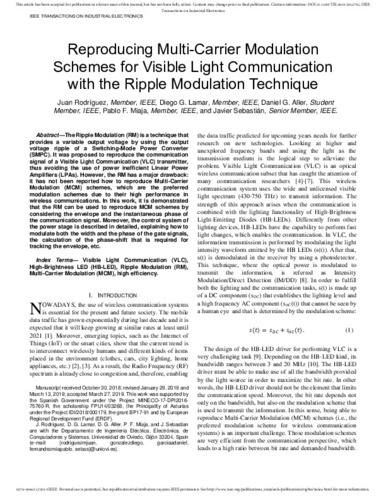Reproducing Multi-Carrier Modulation Schemes for Visible Light Communication with the Ripple Modulation Technique
Fecha de publicación:
Editorial:
IEEE
Versión del editor:
Citación:
Descripción física:
Resumen:
The Ripple Modulation (RM) is a technique that provides a variable output voltage by using the output voltage ripple of a Switching-Mode Power Converter (SMPC). It was proposed to reproduce the communication signal of a Visible Light Communication (VLC) transmitter, thus avoiding the use of power inefficient Linear Power Amplifiers (LPAs). However, the RM has a major drawback: it has not been reported how to reproduce Multi-Carrier Modulation (MCM) schemes, which are the preferred modulation schemes due to their high performance in wireless communications. In this work, it is demonstrated that the RM can be used to reproduce MCM schemes by considering the envelope and the instantaneous phase of the communication signal. Moreover, the control system of the power stage is described in detailed, explaining how to modulate both the width and the phase of the gate signals, the calculation of the phase-shift that is required for tracking the envelope, etc.
The Ripple Modulation (RM) is a technique that provides a variable output voltage by using the output voltage ripple of a Switching-Mode Power Converter (SMPC). It was proposed to reproduce the communication signal of a Visible Light Communication (VLC) transmitter, thus avoiding the use of power inefficient Linear Power Amplifiers (LPAs). However, the RM has a major drawback: it has not been reported how to reproduce Multi-Carrier Modulation (MCM) schemes, which are the preferred modulation schemes due to their high performance in wireless communications. In this work, it is demonstrated that the RM can be used to reproduce MCM schemes by considering the envelope and the instantaneous phase of the communication signal. Moreover, the control system of the power stage is described in detailed, explaining how to modulate both the width and the phase of the gate signals, the calculation of the phase-shift that is required for tracking the envelope, etc.
Patrocinado por:
This work was supported by the Spanish Government under the Project MINECO-17-DPI2016-75760-R, the scholarship FPU14/03268, the Principality of Asturias under the Project IDI/2018/000179, the grant BP17-91 and by European Regional Development Fund (ERDF)
Colecciones
Ficheros en el ítem




